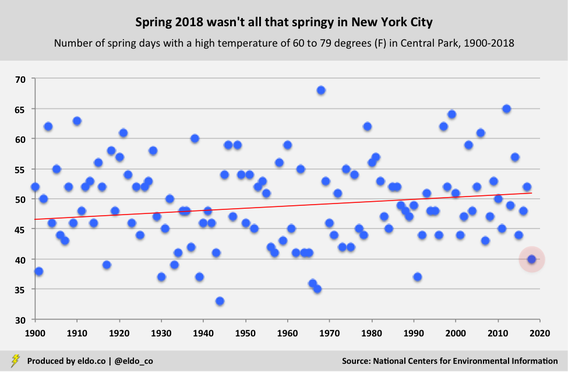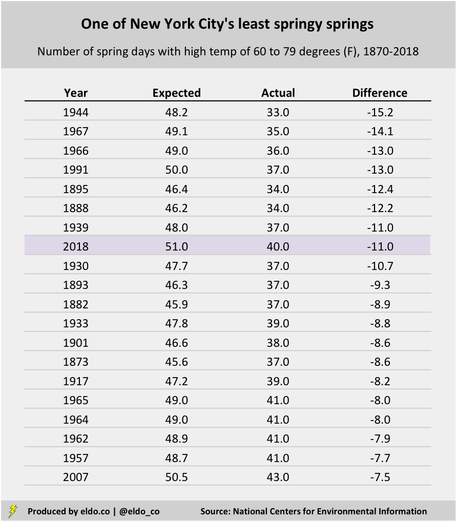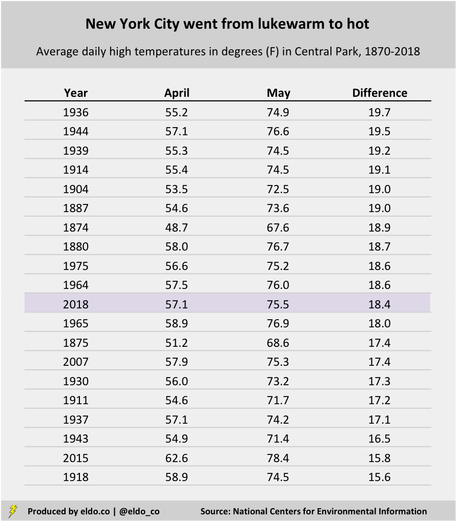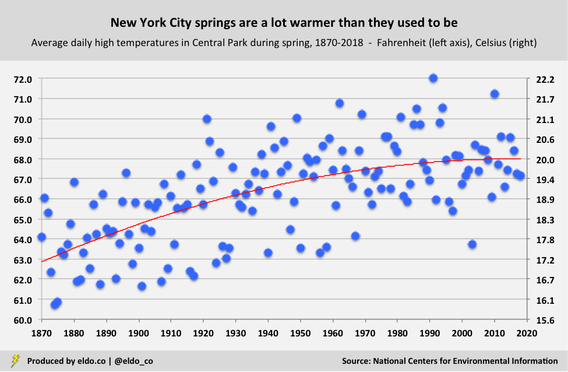|
Spring 2018 officially came to an end last Thursday morning in the United States, and by the time the Fourth of July barbecues are fired up next week, the season that so reliably brings us flowers, baseball, and hay fever will be forgotten. As it turns out, there wasn't much "spring" to remember this year, anyway.
Spring spanned 94 days – March 20 to June 21 – but in New York City and surrounding areas (and many other places, I'm sure), it felt like it came late and left early. If forced elevator conversation is a reliable gauge of people's opinions on the weather, then you might recall strangers and coworkers complaining about how cold it was in mid-April, or how hot it was in early May. And if my own meandering observation is worth its salt, then I, too, felt robbed of that pleasant springtime stretch when it isn't too cold and it isn't too hot – when New Yorkers need not cover their faces from the bite of winter's cold or the sting of summer's stench. But were we really robbed? Did Mother Nature actually shortchange us of "spring"? Was there anything different or special about this past season?
I decided to test those casual observations and elevator conversations against data from the National Oceanic and Atmospheric Administration's National Centers for Environmental Information. I specifically focused on high temperatures in New York City's Central Park, and I took the liberty of defining "spring weather" as any day with a high in the 60s or 70s Fahrenheit. (That's 15.6 to 26.1 degrees Celsius.) From March 20 to June 21, New Yorkers experienced 40 days with a high of 60 to 79 degrees. That's the 10th-fewest "spring-weather" days since 1900. The other 54 days of spring were, of course, either colder (below 60) or hotter (80+) – decidedly "unspringlike" in the eyes of anyone who truly fancies the season.[1]
Another observation we can make is how many such days we had relative to how many we might expect. You may notice that the red trend line in the chart above tilts upward. In 1870, New Yorkers could expect about 45 days with highs in the 60s and 70s during the spring season. Rising temperatures have elevated that expectation to 51 days. In that way, today's New Yorkers generally enjoy the springiest springs of all. [The average high temperature for a spring day in Central Park has increased from 63.5 degrees Fahrenheit in the 1870s to 68.2 degrees this decade. I figured temperatures had risen but was surprised by the magnitude of the increase. That trend has reduced the number of sub-60 degree daily spring highs from approximately 36 to 24, and it's increased the number of 80-plus degree daily spring highs from 14 to 20.] Against that backdrop, our mere 40 spring days with highs of 60 to 79 degrees is even more noteworthy, as it's 11 days below expectation. That's the 8th-largest "below-expectation" recording since 1870, the first year for which complete data is available. It's also one of the few modern years on the list. In other words, not only was spring 2018 unspringlike, it was also far less springy than we've come to expect spring to be:
Average high temperatures tell a similar story. The average high this April was 57.1 degrees, which ranks in the 18th percentile for the month since 1900 – aka cold for April. The average high in May was 75.5, which ranks in the 93rd percentile for that month since 1900 – hot for May. That 18.4-degree difference between average highs in April and May is among the most drastic in recorded New York City weather history:
[If you walked into your office on April 19 with contempt for Mother Nature, you likely weren't alone. The high in Central Park that day was 49 degrees, or 15 degrees below normal.[2] During the first three weeks of April, high temperatures in New York City generally rise from 55 degrees (April 1) to 64 degrees (April 20); this year, highs were in the 40s on nine of those 20 days. And they were 51, 51, and 50 on three others.]
And what of summer, only a fews days young? So far, we're set to have our coldest June 21-to-26 stretch since 1992. The average high of 76 degrees over the six-day span is nearly six degrees below normal, and it's the city's 13th-coldest June 21-to-26 run since 1900.[3] So maybe spring lives on after all – until Friday, that is, when a four-day heat wave is expected to usher in highs of 90, 92, 94, and 92. Enjoy the summer!
Footnotes & Extras
[1] To maintain a consistent baseline of comparison, I defined the spring season as March 20 to June 21 for all years. [2] From 1900 to 2018, the average high temperature in Central Park on April 19 was 63.7 degrees Fahrenheit. [3] From 1900 to 2018, the average high temperature in Central Park from June 21 to 26 was 81.8 degrees Fahrenheit.
The source for this article was the National Oceanic and Atmospheric Administration's National Centers for Environmental Information. Data was compiled and analyzed by ELDORADO. All charts and graphics herein were created by ELDORADO.
4 Comments
1/10/2023 06:06:52 pm
this is one of the best posts, when was the last time you made an article post?
Reply
9/20/2023 06:29:50 am
Thank for the information, please visit
Reply
The blog post you shared was truly a treasure, brimming with valuable ideas and engaging narratives! Your unique way of writing, characterized by humor, vivid details, and smart analogies, truly brought the topic to life in my mind. It felt like I was taking a journey alongside you. I can't wait for your next blog post, and I'll definitely be on the lookout for it.
Reply
Leave a Reply. |
|





 RSS Feed
RSS Feed